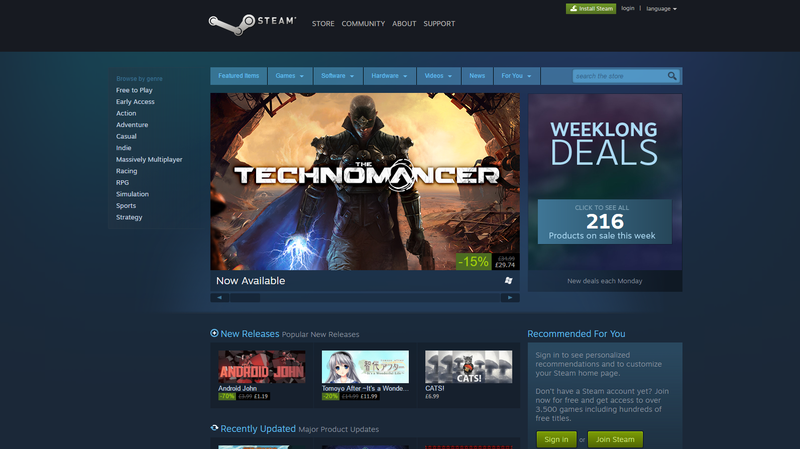
We all know that the Apple Mac is fundamentally a better computer than any PC you could name. You know that too, or we highly doubt you’d be on our website. Not only are they better machines, but they also run on better software. Windows isn’t quite as atrocious as it used to be these days (although we all remember how woeful Windows Vista was, and we should never let Microsoft forget that), but it’s still no match for the cleanliness of macOS.
Historically, though, Windows has always had one advantage over macOS, and it’s all down to the availability of games. Windows is the more popular system, and so all the best games for home computers are created with Windows users in mind. Sometimes we get a macOS version, and sometimes we don’t. Over the years, that’s been a bit of a sore point for a lot of Mac users. Now it would appear that a workable solution may finally be at hand.
There have been many ‘workaround’ solutions proposed to enable systems running on macOS to play Windows games, but none of them have felt particularly satisfactory. Even the ‘how to’ guide on the usually-reliable WikiHow website is rated at only two stars out of five, because it doesn’t produce the kind of results we should be entitled to expect. Forcing compatibility has never been an issue – it’s graphics which have always posed the problem, and it’s graphics that the new solution is focused on.

Before we get into the solution, we should be clear on what we mean by ‘games.’ ‘Gaming’ can mean any number of things, from ‘Call of Duty’ to mobile slots. It’s the former category we mean here. Gambling games, by design, don’t require a lot of computer power. Mobile slots are designed to be available to anybody who wants to play them (hence the name ‘mobile slots’ – they’re now completely functional on mobile phones whether we’re talking iPhones or Android devices). You should notice no difference loading the majority of online or mobile slots no matter which device you load them on. The latest big-studio MMO release, however, might be an issue.
The solution comes in a new development within the Parallels Desktop software, which has been the most reliable route to running a stable version of Windows on Macs for some time. By using Apple Metal, Parallels Desktop is now capable of supporting DirectX 11. In layman’s terms, that means rendering 3D graphics is now much faster – some estimates put the improvement as being close to 20%. That takes graphic-intensive games from being a glitchy mess to being smooth and playable. It’s not perfect – we don’t expect anything will ever be as smooth as running a game natively on the platform it was built for – but we can now say that it’s a viable route for gamers if they want to take it.

The newest version of Parallels Desktop is the fifteenth in the series, and has a few more tricks up its sleeve aside from just making your games run faster. The software’s developers have listened to feedback about how impractical it was to run Microsoft Office through the program, and have made some adjustments accordingly. They haven’t quite managed to double the emulation speed that Parallels Desktop 14 was capable of, but they have increased it by a factor of around 80%. Again, it’s not quite as fast as running it on a high-end PC, but if you want to run Office on a Mac, it’s about as good as you’re going to get. That is, of course, unless they find a way of taking yet another big step forward when they get around to launching version 16 of the software.
With Parallels Desktop 15, you can almost turn your machine into a PC/Mac hybrid – especially if you’re running with two screens, or with an iPad connected to your Mac. The Sidecar feature in macOS Catalina has proven to be popular, and it’s been implemented to good effect here. If applied correctly, you should now find that you’ll be able to use your iPad to open Windows apps with a minimum of fuss. Sharing has also been improved, allowing you to literally ‘drag and drop’ items between Windows and macOS where compatibility allows for it.
Innovation doesn’t come cheaply, but if you’re serious about achieving full Windows emulation on your Mac, you’re probably expecting to pay a premium for the privilege. Buying Parallels Desktop 15 as a brand new product will cost you $99.99, although it’s only half that price if you’re upgrading the software from a previous version. Subscription options are also available. It will only be compatible with the most recent version of macOS, so make sure you’re completely up to date before you attempt installation if you decide to purchase the product.
So there we have it – it might cost you one hundred dollars, but you can now play Windows games on your Mac without feeling like you’re enduring a second-class version of the same game that players are enjoying on the PC. You could of course just buy a mid-range PC for gaming purposes – but where would be the fun in that? All of this may be a moot point in a year’s time – if Google Stadia takes off the way that Google expects it to, none of us will be relying on hardware to play games anymore anyway. We’ll just log in through a web portal and play games on any screen we like, with functionality that’s believed to work in in a very similar way to Netflix. Pay your subscription fee, play your game, and don’t worry about the demand it’s putting on your device. If it does everything it’s supposed to do, then the days of software developers having to worry about coding different versions of a game for different platforms are over – but we won’t know if that’s going to be the case until it launches.
We’ll endeavor to bring you more news about Mac gaming platforms – or platforms that affect Mac gaming – whenever it becomes available, so make sure you keep checking the site!
